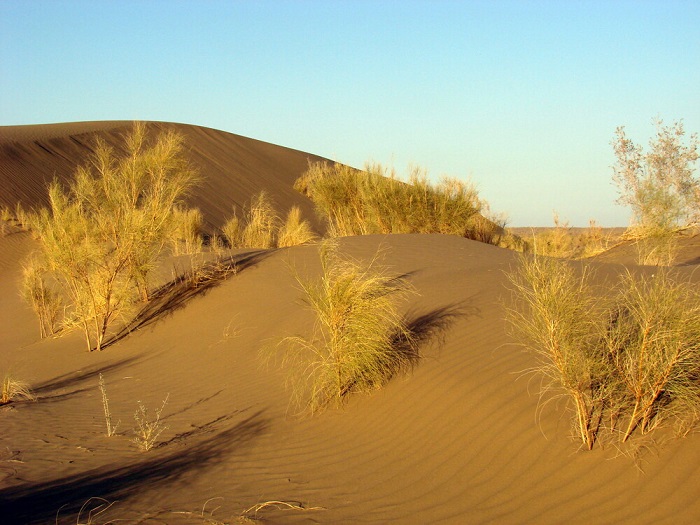In the last two parts of this series we reproduced the complete research paper of Professor Pavlenko, which he read at the International Cold Winter Desert Conference in the framework of CADI (Central Asia Desert Initiative), held 2-3 December 2021 in Tashkent.
The purpose was to highlight the complexity of work of a desert scientists. When they go out there, they are not merely playing with the sand, although they certainly enjoy doing that. Their time is spent under strict discipline in arduous conditions. Sometimes it takes several years of work to produce a research paper.
This is the last part of the series and we will briefly mention here some other papers presented at the same conference. In doing so, we are underlining the wide range of tasks that land in the assignment box of a desert scientist.
The title of a paper presented by M.A. Gritsina and T.V. Abduraupov of the Institute of Zoology of the Academy of Scientists of Uzbekistan, and N.V. Marmazinskaya of the Zarafshan National Nature Park was rather humorous. It was: Assessment of the conflict situation between the Bukhara Deer
(Cervus Hanglu) and the local population in the lower Amudarya biosphere reserve
At the opening of the paper, they said that the Bukhara deer population in the Lower Amudarya State Biosphere Reserve (LABR) was increasing every year. While it was the proof of success of the conservation work, the naturally available food was not enough for the growing population of the Bukhara deer. Consequently, they were foraging into the crops of the local farmers.
Among the recommendations they offered, there was one idea that sounds quite reasonable. They said that the cultivated area should be increased and the outer strips of the fields should be sown with the fodder that is suitable for the deer. This way, the deer would be well-fed without damaging the crops meant for human consumption.
‘Protecting the cats of the cold winter deserts in Turkmenistan and western Kazakhstan’ was the title of a paper presented by Rosen Tatjana, Amanov Arazmurat, Barashkova Anna, Dieterich Til, Hojamuradov Hojamurad, Hudaikuliev Nurmuhammet, Karryeva Shirin, Kaczensky Petra, Mengliev Shanyaz, Muhashov Aktan, Nurmuhambetov Zhaskairat, Pestov Mark, Potaeva Aknabat, Smelansky Ilya, Terentyev Vladimir, Veyisov Atamyrat, and Linnell John D. C. from Kazakhstan, Turkmenistan, Russia and Norway. [16 authors for his paper!]
They said that the cold deserts represent a globally unique ecosystem with rather distinctive community assemblages often consisting of both tropical and temperate species. For example, on a broad scale the wild cat community contains up to seven species: namely the Persian leopard (Panthera pardus tulliana), caracal (Caracal caracal), Eurasian lynx (Lynx lynx), Pallas cat (Otocolobus manul), Asiatic wild cat (Felis lybica ornata), Jungle cat (Felis chaus), and sand cat (Felis margarita) (Kitchener et a. 2017).
 They pointed to the success of the conservation efforts in the protected areas and appealed to the respective governments to consider increasing the size of some of the protected areas.
They pointed to the success of the conservation efforts in the protected areas and appealed to the respective governments to consider increasing the size of some of the protected areas.
In a paper titled ‘Assessing the impact of border fences on goitered gazelle populations in Kazakhstan,’ Dieterich, T., Pestov M.V., Nurmukhambetov Zh. E., and Terentyev V. A. said that the goitered gazelle (Gazella subgutturosa Güldenstädt, 1780) is on the Red Book of the regional countries as declining or threatened species, and the IUCN as vulnerable species.
They found that the inhospitable natural conditions were causing challenges to the population of the goitered deer. They did not recommend any concrete steps but just asked the authorities to take notice of the situation.
* * *
The desert scientists are unfortunately a stagnating community. There is not the proportionate number of young people joining the community to keep up with the increasing complexities in the desert studies. Some of the work can be tasked to drones, remote sensors, AI, and other modern tools and technologies but nothing can replace a competent and experienced desert scientist.
It is but natural that the talented people (and quite a few not so talented people) seek quick fame, popularity, glamour, and a ton of material comforts. They try their luck on the social media and out of several hundreds of thousands, one makes it to the cherished spot.
The authorities need to think of some way to systematize the social media fame and popularity for the desert scientists by providing them with the professional production teams to beam their advertures in the desert to the youtube and Instagram followers. After all, they have much more exciting and genuine narrative to offer than the run-of-the-mill influencers who try to make a living by peddling substandard clothes and cosmetics, and disrespecting others.
Our respect to the desert scientists in Central Asia and everywhere else. /// 17 May 2024 [CONCLUDED]
